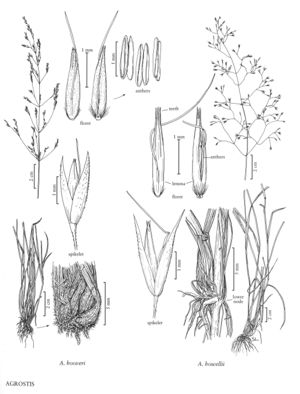Agrostis hooveri
Plants perennial; cespitose, not rhizomatous, not stoloniferous. Culms 30-80 cm, erect, usually with more than 3 nodes. Leaves mostly on the lower 1/2 of the culm; basal leaves withered by anthesis; lower leaf-sheaths finely tomentose, the tomentum extending to below-ground; upper leaf-sheaths smooth; ligules 2.5-6 mm, dorsal surfaces scabridulous, apices acute to truncate, lacerate; blades 10-16 cm long, 0.5-1 (2) mm wide, flat, becoming involute. Panicles (4) 10-17 cm long, 2-5 cm wide, broadly lanceolate, usually open, exserted from the upper sheaths at maturity, lowest node with 1-8 branches; branches scabrous, generally ascending, mostly branching at about midlength, sometimes to near the base, lower branches 1.5-5 cm; pedicels 0.4-5 mm. Spikelets lanceolate, slightly purplish. Glumes equal to subequal, 1.8-3 mm, 1-veined, scabridulous on the veins, sometimes also on the body, acute; callus hairs to 0.3 mm, abundant; lemmas 1.5-2 mm, scabridulous to warty throughout or only on the veins, translucent to opaque, 5-veined, veins prominent distally, apices truncate, minutely toothed to about 0.2 mm, awned on the lower 1/3, awns to 2.5 mm, geniculate, persistent; paleas absent or minute; anthers 3, 1-1.5 mm, usually shed at anthesis. Caryopses 1-1.5 mm; endosperm liquid. 2n = unknown.
Discussion
Agrostis hooveri is an uncommon species, endemic to dry, sandy soils, open chaparral, and oak woodlands of San Luis Obispo and Santa Barbara counties, California.
Selected References
None.
Lower Taxa
"decumbent" is not a number.
